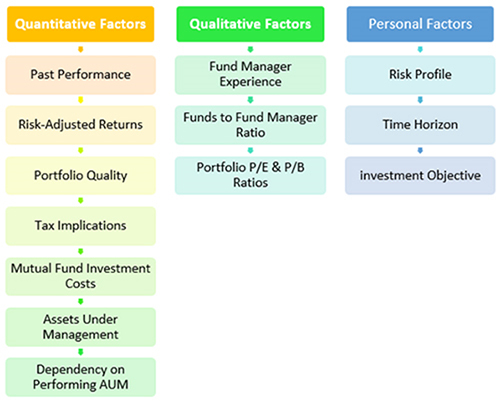All You Need to Know About the Rolling Returns of Mutual Funds
Rounaq Neroy
Oct 21, 2022
Listen to All You Need to Know About the Rolling Returns of Mutual Funds
00:00
00:00
"I invested in a mutual fund scheme a year ago, but why do the scheme returns as per its factsheet don't match my computation?"
Novice Investors often raise such queries. If you too have wondered about mutual fund returns at any time, this article is for you.
First of all, don't get confused. When you measure the performance of your mutual fund investments, you consider point-to-point returns. On the other hand, mutual fund houses typically use Rolling Returns to demonstrate their performance.
Let's understand the difference between point-to-point returns and rolling returns
Rolling Returns -- These returns are the averages of returns calculated at a fixed frequency for a specified time period and hence are also called rolling period returns. For instance, if you are calculating a rolling return on a daily frequency for a 1-year time horizon between 18th October 2021 and 18th October 2022; you will calculate 1-year returns for all days between 18th October 2021 and 18th October 2022 and take their average.
Instead of a year, if you want to know the performance of a scheme on 3 years period between 18th October 2019 and 18th October 2022, you will calculate the 3-year return for every single day between these dates (assuming daily rolling) and consider their average as the 3-year rolling returns.
When computing rolling returns, you might use different rolling frequencies, say weekly rolling, monthly rolling, etc.
Point-to-point returns -- These returns, on the other hand, tell you how a mutual fund scheme has performed point-to-point, i.e., between two specified dates -say over a week, month, quarter, a year, 2 years, 3 years, 5 years, etc. It does not take into account smoothened average over these time periods. It simply considers the end value and beginning value of your investment.
In other words, the returns are expressed in absolute terms or point-to-point for the respective time period. If you have invested in any mutual fund scheme in a lump sum, it may be okay to compute point-to-point returns with the difference in the Net Asset Value (NAV), but it will not provide any indication of how the fund fared in the interim over the given period and therefore is a bit misleading.
Which is better - Point-to-point Returns or Rolling Returns?
Presenting point-to-point returns in investor communications and marketing literature is not appropriate for mutual funds. This is because point-to-point returns just tell the performance for the respective point in time and not over the period of time.
Say, for instance, the NAV of a mutual fund scheme was Rs 20, six months ago, which was its 52-week low. Thereafter, markets witness a sharp rally and now the NAV of the scheme has jumped to Rs 24-a 20% rise. Now, if a mutual fund claims it has made 20% returns over the last 6 months, it would be a misrepresentation.
You see, over longer time periods particularly, markets go through various phases, which you can't afford to ignore while weighing the performance of your mutual fund scheme.
As against this, daily rolling returns will measure the returns for each day, thereby ironing out the lop-sidedness in the NAV due to market volatility or the recency bias.
Consider one more example. Suppose you invested in a mutual fund scheme five years ago i.e., on 18th October 2017, between then and now, the scheme NAV has more than doubled. But for the first two and half years, it generated lacklustre returns. In other words, the bulk of returns has come in the last two-and-half years. Computing the point-to-point returns won't give you any clue about the back-loading (or front-loading) of returns due to the recency bias.
Using the rolling returns provides smoothed returns over the period chosen and is a better means of assessing the returns for you, the mutual fund investor, over the holding period. It gives a better insight into how the scheme has fared and does not distort the reading due to the recent upswing and downswings. On the contrary, it captures the performance well of both stronger and poorer periods.
In short, what are the advantages of using Rolling Returns to evaluate a mutual fund scheme's performance?
✔ Give you a more realistic picture of the performance
✔ Eliminates the risk of recency bias or any other
✔ Helps even out lop-sidedness on account of high market volatility
✔ Captures the returns across market phases (bull, bear, and consolidation)
✔ Help measure the consistency in returns and potential outperformance of the scheme
✔ Comparing the rolling returns of the scheme vis-a-vis its benchmark throws light on the value added by the fund manager
 (Image source: freepik.com, image created by @fabrikasimf)
(Image source: freepik.com, image created by @fabrikasimf)
Join Now: PersonalFN is now on Telegram. Join FREE Today to get 'Daily Wealth Letter' and Exclusive Updates on Mutual Funds
Here's how some of the top equity mutual funds have fared on rolling returns and point-to-point returns...
Table 1: Rolling returns vs. point-to-point returns
| Scheme Name |
Return Calculation Method |
Returns (Absolute %) |
Returns (CAGR %) |
| 1 Year |
2 Years |
3 Years |
5 Years |
7 Years |
| Quant Active Fund |
Rolling |
35.9 |
52.4 |
34.3 |
24.0 |
19.8 |
| Point-to-Point |
2.4 |
44.2 |
35.6 |
23.0 |
20.6 |
| PGIM India Midcap Opp Fund |
Rolling |
35.9 |
54.6 |
37.2 |
21.1 |
17.4 |
| Point-to-Point |
0.9 |
42.9 |
39.6 |
20.4 |
17.8 |
| Parag Parikh Flexi Cap Fund |
Rolling |
23.8 |
35.9 |
26.7 |
20.5 |
17.7 |
| Point-to-Point |
-6.9 |
23.9 |
24.0 |
17.6 |
17.2 |
| UTI Flexi Cap Fund |
Rolling |
15.1 |
31.4 |
22.0 |
17.2 |
14.0 |
| Point-to-Point |
-13.2 |
22.7 |
19.3 |
14.5 |
13.4 |
| Mirae Asset Large Cap Fund |
Rolling |
16.5 |
26.7 |
17.2 |
15.0 |
14.4 |
| Point-to-Point |
-5.6 |
22.8 |
16.1 |
12.4 |
14.2 |
| Nifty 500-TRI |
Rolling |
19.0 |
29.9 |
18.1 |
14.4 |
12.8 |
| Nifty 500-TRI |
Point-to-Point |
-4.0 |
26.5 |
17.9 |
12.2 |
13.2 |
Direct Plan and Growth Option considered.
Past performance is not indicative of future returns. Mutual Fund investments are subject to market risks. Read all scheme-related documents carefully.
Speak to your investment advisor for further assistance before investing
Data as on October 18, 2022
(Source: ACE MF, PersonalFN Research)
The comparison between point-to-point returns and rolling returns reveals one more crucial factor about mutual fund investing. If you invest just one time or invest too infrequently, your portfolio return would always be at the mercy of markets. As against that, if you invest through a Systematic Investment Plan (SIP), you can mitigate the risk involved with the inherent rupee-cost averaging feature of SIPs, and not have to worry about timing the markets.
[Download PersonalFN's free Money Simplified Guide- SIP: A Rewarding Strategy - Everything You Need To Know]
A SIP allows you to invest little amounts at regular periods, such as weekly or monthly and units are allotted for the amount invested in each instalment. SIPs help in goal planning and ensure that you stay on the right track to accomplish the envisioned financial goals.
[Read: How to Use XIRR While Calculating SIP Returns]
That being said, select mutual fund schemes for your investment portfolio prudently. Thanks to technology, you may compare the returns of your mutual fund scheme by using the online free mutual fund screeners. Use various filters based on the fund category and the benchmark performance to spot the best-performing mutual funds capable of generating optimal returns for you.
However, while short-listing schemes for your portfolio, avoid just looking at short-term returns. Assess mutual fund scheme performance (rolling and risk-adjusted returns) over longer time periods and market cycles. Furthermore, pay close attention to a whole host of quantitative and qualitative factors.
Image: Factors to consider for selecting a winning mutual fund

It would also do well to understand the ideologies of the fund house and the investment processes and systems it follows.
Make a wise choice, considering your risk profile, broader investment objective, financial goals, and time in hand to achieve those envisioned goals.
If you wish to invest in a winning mutual fund without undertaking any exhaustive research on your own, I suggest subscribing to PersonalFN's flagship mutual fund research service, FundSelect.
PersonalFN's FundSelect is driven by S.M.A.R.T processes-
S - Systems and Processes
M - Market Cycle Performance
A - Asset Management Style
R - Risk-Reward Ratios
T - Performance Track Record
This stringent process has helped our valued mutual fund research subscribers to own some of the best mutual fund schemes in their investment portfolio with a commendable long-term performance track record.
PersonalFN's FundSelect service provides insightful and practical guidance on which mutual fund schemes to Buy, Hold, and Sell.

This service is apt if you are looking for insightful guidance and recommendations on some worthy funds having high growth potential in the years to come.
Currently, with the subscription to FundSelect, you could also get Free Bonus Access to PersonalFN's Debt Fund recommendation service DebtSelect.
We will also provide you with direct recommendations on the best Equity Linked Saving Schemes (ELSS) to invest in 2022, whereby you can save tax.
If you are serious about investing in a rewarding mutual fund scheme, subscribe to FundSelect now!
Happy Investing!
Warm Regards,
Rounaq Neroy
Editor, Daily Wealth Letter